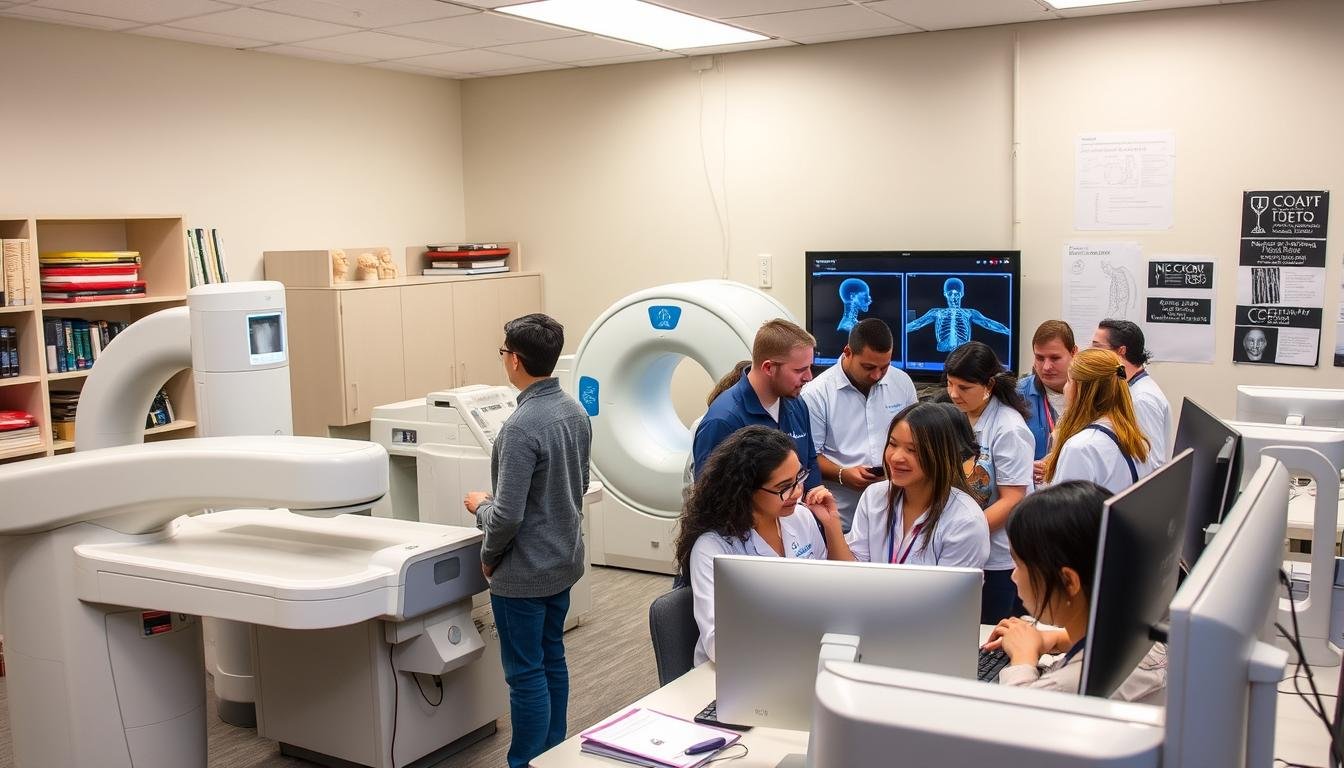Radiology techs play a vital role in healthcare. This career offers job stability and competitive salaries.
The path to becoming a radiology tech can vary. Understanding the steps and requirements helps plan your journey.
This guide explores the education, training, and certification needed and provides a clear roadmap to achieving your goals.
We’ll help you navigate the process. You’ll learn about the time and effort needed to succeed.
A modern radiology technician in a bright hospital room, operating advanced imaging equipment, focusing on a patient being scanned, surrounded by medical monitors and equipment, showcasing teamwork and professionalism in healthcare, warm lighting, and a clean aesthetic.
Understanding Radiology Technology
Radiology is key in healthcare. It uses advanced imaging to help diagnose and treat patients.
Radiology technicians operate imaging equipment. They assist doctors in understanding the results.
These experts use X-rays, CT scans, MRI, and ultrasound. They capture detailed images of the human body.
Medical imaging helps identify and treat many conditions. It can show broken bones and even cancer.
Technicians are vital to patient care. They ensure imaging equipment works well.
Radiology technicians do more than run machines. They keep patients safe and comfortable during imaging.
They also clean and maintain the equipment. This helps ensure high-quality images for treatment decisions.
Education Requirements for Radiology Techs
Radiology techs must complete a two-year program in radiologic technology. This program teaches anatomy, patient care, radiation physics, and imaging techniques.
To start, you need a high school diploma or GED. Some programs also require classes in biology, chemistry, and math.
Most radiology techs start with an associate degree in radiologic technology. These programs are found at community colleges, tech schools, and some universities.
Students learn in classrooms and get hands-on training. They gain experience with X-rays, CT scans, MRIs, and ultrasounds.
It’s essential to choose an accredited program. This ensures it meets national standards for teaching and training.
After finishing, students can take the ARRT certification exam, which is required to work in most states.
Accreditation and Licensing
Becoming a radiology tech requires more than just education. You need ARRT certification and a state license to practice.
The American Registry of Radiologic Technologists (ARRT) certifies radiology professionals. You must complete an accredited program and pass an exam.
ARRT certification shows you can perform radiologic procedures safely. It proves you have the needed skills and knowledge.
Most states require radiology techs to have a valid license, but requirements vary by state, so research your area’s rules.
You may need extra coursework or a state-specific exam. Check with your state’s licensing board for details.
ARRT certification and state licensure are key to success. These credentials validate your skills and ensure top-quality patient care.
Duration of Educational Programs
Radiology tech programs usually take 18 to 24 months to complete. These programs teach medical imaging, radiation safety, and patient care.
Accelerated programs can be finished in 12 to 18 months. They offer intensive coursework and flexible schedules for faster completion.
Program length can vary based on prior education and course load. Some students may need to take prerequisite courses first.
Most students finish their radiology tech education in 18 to 24 months, after which they can start their careers in the field.
Clinical Training and Internships
Radiology technicians need extensive clinical training to develop practical skills. Students complete a radiology internship to gain hands-on experience in various healthcare settings.
The internship is crucial for applying classroom knowledge to real-world scenarios. Under expert supervision, interns learn to operate imaging equipment and interpret diagnostic images.
Clinical training usually lasts around 1,000 hours or more. This hands-on experience prepares graduates to excel as radiology technicians.
Graduates gain the knowledge and confidence to provide excellent patient care. They are well-equipped to contribute effectively to the healthcare team.
Additional Certifications
Radiology techs can get special certifications to boost their careers. These focus on specific imaging types, such as CT, MRI, or mammography.
Special certifications can lead to new job chances. A CT-certified tech might work in emergency or trauma centers.
An MRI-certified tech could focus on brain or bone imaging. These tests show a tech’s dedication to learning and providing excellent care.
Standard extra certifications include ARRT credentials in CT, MRI, and mammography. These help techs advance and give better care to patients.
Job Market and Demand
Radiology techs have a bright future. The U.S. Bureau of Labor Statistics predicts 9% job growth from 2019 to 2029.
This growth outpaces other jobs. It shows the rising need for healthcare services.
As people age, more radiology pros are needed. New imaging tech also boosts demand for skilled techs.
Most jobs are in hospitals and imaging centers. Outpatient care facilities also need radiology techs.
The healthcare field is changing fast. Techs with special skills may have an edge.
A career as a radiology tech looks promising. With proper training, you’ll find many job options.
Alternative Training Routes
Becoming a radiology tech can sometimes require an associate’s degree. Other options exist for advanced radiology education and flexible study.
Bachelor’s degree programs offer in-depth coursework in radiologic technology. These programs can open up more career opportunities.
Online education is another choice for aspiring radiology professionals. Distance learning allows students to study at their own pace.
Flexible study options help those with busy schedules or location constraints. Students can often work while pursuing their education.
Choose an accredited program recognized by professional associations. This ensures quality education and helps with licensure.
Accredited programs also prepare graduates for necessary certifications. These are important for practicing as a radiology tech.
Continuing Education and Specialization
Radiology techs need ongoing education for career growth. Specialized imaging techniques require constant learning to stay current in the field.
Mastering specialized imaging is key to success. Pursuing extra certifications can make you an expert in specific areas.
Professional development helps you stay up-to-date with industry trends. This dedication improves your job satisfaction and career prospects.
Factors That Affect Transition Time
A career as a radiology tech is rewarding. The time to transition can vary based on several factors.
Your dedication and study habits play a key role. Local job market conditions also affect the process.
Time management is crucial during training. Stay organized and focused on completing your program efficiently.
Develop effective study techniques. Create a study schedule and use practice exams.
Maintain a positive attitude. Stay motivated throughout the process to boost your success.
Job availability in your area matters. Some regions have a high demand for radiology techs.
Other areas may have more competition. Stay informed about the local job market.
Network with professionals in the industry. This can help you find the correct position faster.
Your commitment shapes your career timeline. Focus on these factors to optimize your path.
With dedication, you can achieve your professional goals. Becoming a radiology tech is within reach.
A bustling radiology tech classroom with students engaged in hands-on learning, advanced imaging equipment like X-ray machines and MRI scanners in a modern lab setting, shelves lined with medical textbooks and anatomy models, bright ambient lighting creating an inviting atmosphere, a wall displaying anatomical diagrams and radiology images, focused expressions on students as they practice techniques, a diverse group of individuals collaborating around a workstation.
Conclusion: Your Path to Becoming a Radiology Tech
Becoming a radiology tech requires education, training, and ongoing learning. This career offers challenges and rewards in healthcare.
The field of medical imaging presents many chances to grow. You can make a real difference in patients’ lives.
Your journey to becoming a radiology tech is unique, and the time it takes to reach your goals may vary.
With dedication and learning, you can start an exciting career. Embrace challenges and celebrate successes in this dynamic field.
FAQ
How long does it take to become a radiology tech?
Becoming a radiology tech usually takes 2 to 3 years. This includes classroom learning and hands-on training.
What are the educational requirements for a radiology tech?
An associate degree in radiologic technology from an accredited school would be helpful. The program covers anatomy, patient care, radiation physics, and imaging techniques.
Do radiology techs need to be licensed or certified?
Most states require radiology techs to be licensed or certified. The primary certification is the ARRT, which involves passing an exam.
Some states may have their own licensing rules for radiology techs.
How much clinical training is required for radiology techs?
Clinical training is key for radiology techs. Most programs need 1,000 to 1,500 hours of supervised practice.
Students learn hands-on imaging skills during this time.
Can I become a radiology tech through an accelerated program?
Yes, some schools offer fast-track programs lasting 12 to 18 months. These are for people with a bachelor’s degree in a related field.
What are the career prospects for radiology techs?
The job outlook for radiology techs is good. Jobs are expected to grow 9% from 2020 to 2030.
This growth is due to more demand for medical imaging.
Can radiology techs specialize in specific imaging modalities?
Yes, radiology techs can get extra certifications in specific areas, such as CT, MRI, mammography, or heart imaging.
Special skills can lead to better job chances in medical imaging.
you may also read:What Is Tech Debt: Understanding Digital Challenges

